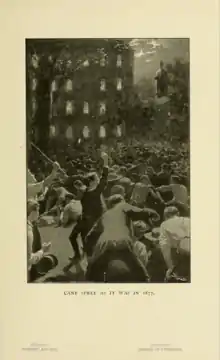Cane Spree
Cane Spree is an annual autumn tradition at The College of New Jersey (referred to then as Princeton College and now known as Princeton University) which began during the Gilded Age -- the period just after the Civil War, or the mid-to-late 1860's. Cane Spree began as a riot between classes, turned into an annual event with each class designating a candidate for the wrestling, and ultimately shedded its violence altogether to become a regular intramural multi-sport event held on the campus. The tradition endures today.

History
In the Gilded-Age of the 1860's, fashionable and elegant gentlemen carried walking sticks (canes). At Princeton College, sophomores were offended by seeing underclassmen carrying canes and would attack freshmen students found carrying canes in a sort of hazing ritual.

What eventually became known as Cane Spree began as an actual riot on Nassau Street in Princeton, New Jersey where sophomores "provoked by freshmen flaunting their canes"[1] attacked the freshmen, and relieving them of their canes in the process.[2] Later, Cane Spree (in its modified, non-violet form) became a common form of hazing on campus, ultimately becoming what was considered the "first intramural sport" at the college. In 1868, sophomores officially proclaimed a ban on all freshmen, prohibiting them from carrying canes on campus. Any freshman found carrying a cane was subject to attack from sophomores, their canes taken in the process.
The rules of Cane Spree were simple -- there were no rules -- except for a rule against biting.[3] Cane Spree was described by Harrington DeGoyler Green as that [...Cane Spree would] "weld the class together and put some spirit in it."[3] This was important because class identity and bonding is an important virtue at Princeton University.[4] The 1868 Cane Spree inspired a song called "Siege of Canes."[5][6]
Sometime in the 1870's the Princeton University administration attempted to implement controls to minimize the violence, however random attacks continued.[6] On September 15, 1870, James McCosh (President of Princeton College) interrupted a brawl between sophomores and freshmen and shouted "Disperse, young men, or the bailiffs will be after you."[7] By 1891, Cane Spree was formally abolished, but the class fighting continued informally. Between the 1880's and early 1900's as Cane Spree became an officially organized event; prominent newspapers would carry news of the winners, losers as well as details of what privileges the losers must relinquish.[6][8][9][10][11] Throughout the years, it was said that winning a cane in Cane Spree was "the honor of a lifetime".[12]
Cane Spree was reported in the New York Times,[8][9][10][11] Scribner's Magazine,[13] as well as local and university publications.[1][3][5][12]
While it has changed significantly since its origins in the 1860s, Cane Spree is a tradition that endures today, taking place in Princeton's football stadium in early October as a friendly and fun multi-sport battle for supremacy between the freshmen and sophomore classes.
Canes
The canes (walking sticks) carried by students were intricately carved and decorated by the class members themselves who etched their autograph or decorative mark onto the cane. Many of the markings detail the intended profession or area of study of the engraver. Canes were passed around for each carved name to be added then returned to their owner.
- Hand-carved walking stick from Princeton College class of 1881 student
 Full-length view of top portiion
Full-length view of top portiion Side view, 3/4 length
Side view, 3/4 length Top front view
Top front view Side view
Side view Close up view of engraved names
Close up view of engraved names
Notable Names
Several of the names carved on the Princeton College class of 1881[14] cane pictured above are members of prominent Gilded Age families and/or went on to become notable historical figures:
| Dr. Atwater | Charles E. Dunn | John Oliver Halsted Pitney |  Princeton college class of 1881, 25 years later. |
| A. C. Armstrong | Jack Fowler | Charlie Ryle (Charles Danforth) | |
| James R. Archer | T. H. Powers Farr | David Adams Haynes | |
| Adam Todd Bruce | Francis Loney | Arthur A. Scribner | |
| Charles Henry Butler | Francis G. Landon | Robert Rogers Shellabarger | |
| Benjamin B. Blydenburgh | Samuel H. Myers | Lewis H. Stanton | |
| Thomas W. Cauldwell | Henry McAlpin | James Augustus Webb, Jr. | |
| Frank Gledhill | Dr. James McCosh | A. Pennington (Penn) Whitehead | |
| Edward Floyd Crosby | William (Billy) Ingham | Paul VanDyke | |
| Henry G. Duffield | Henry M. Payne |
References
- "Cane Spree | Princetoniana". princetoniana.princeton.edu. Retrieved 2021-01-06.
- "From Princeton's vault: The lost art of autograph canes". Princeton Alumni Weekly. 2016-01-21. Retrieved 2021-01-06.
- "Harrington DeGoyler Green Letters | Princeton University Library Special Collections". library.princeton.edu. Retrieved 2021-01-06.
- Dominique, Simone (2016-11-16). "What It's Like to Help One of the World's Richest Universities Get Richer". The Atlantic. Retrieved 2021-01-06.
- Cane Spree to Start Monday; History Dates From Clashes of Sixties. The Daily Princetonian. Saturday, September 29, 1934. Volume LIX, No. 99; Page 1
- Armstrong, April C. (2020-10-26). "This Week in Princeton History for October 26-November 1". Mudd Manuscript Library Blog. Retrieved 2021-01-06.
- "September 2020". Mudd Manuscript Library Blog. Retrieved 2021-01-06.
- "COLUMBIA CUBS DEFEATED.; Lose Cane Sprees to Sophomores and Also Lose Smoking Privilege. (Published 1917)". The New York Times. 1917-02-13. ISSN 0362-4331. Retrieved 2021-01-06.
- "PRINCETON BOYS PLEASED.; The Revival of the Old Midnight Cane Spree. (Published 1895)". The New York Times. 1895-11-04. ISSN 0362-4331. Retrieved 2021-01-06.
- "HONORS WERE EASY.; THE CANE SPREE OF THE PRINCETON STUDENTS. (Published 1888)". The New York Times. 1888-10-26. ISSN 0362-4331. Retrieved 2021-01-06.
- Times, Special to The New York (1905-11-29). "CANE SPREE AT PRINCETON.; Sophomores Defeat the Freshmen for First Time in Many Years. (Published 1905)". The New York Times. ISSN 0362-4331. Retrieved 2021-01-06.
- "Download Princeton Stories free in PDF & EPUB format". Princeton Stories - Download book - PDF EPUB - Freeditorial. Retrieved 2021-01-06.
- "Frist Campus Center Iconography". www.princeton.edu. Retrieved 2021-01-06.
- Student Name Index Project. College of New Jersey, Princeton University. Richard Parker organ Databases of the American Antiquarian Society.